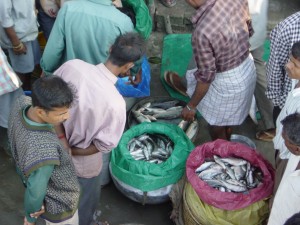Food
Protected areas support food security through providing habitat for wild pollinators, sustaining populations of wild food species; providing genetic material for crop breeding, and maintaining long established cultural landscapes.
Pollination is needed for about three-quarters of the world’s food crop; but wild pollinators are declining globally. Protected areas serve as havens for pollinators and maintaining populations that can replenish those on farmlands if the latter are destroyed by careless use of insecticides. Protected areas also supply wild honey for collection and sites for beekeepers to keep their hives.
In many protected areas, local people have agreements with protected area managers to collect materials for subsistence food or local sale, including herbs, fish, fodder and common wildlife species. Such use should not lead to decline or loss of the collected species and harvest limits, zoning and controls on collection methods are all used to help achieve sustainability. Wild food collected in protected areas can also provide a safety net during periods of food shortage, economic troubles, crop failure, or for the poorest members of society.
Protected areas can ensure safe breeding grounds and sanctuaries for species that are hunted for food, thus maintaining populations. This is particularly the case for marine and freshwater fish, where protected areas can boost both numbers and average size of fish by allowing safe havens for breeding, and for juvenile fish to grow. As fish stocks increases within marine protected areas, fish start to spill-over into surrounding waters, providing additional catch for fishing operations.
Crop wild relatives (CWR), valued in the tens of billions of dollars annually, enable farmers and scientists to breed commercial crops that are resilient to new pests and diseases, drought, flooding and heat. While ex situ strategies such as seed banks are important for research, protected areas are the only means of ensuring long-term genetic diversity for many species. Additionally, special small reserves in cultural landscapes are being set up in some countries to protect traditional land-races of crops that are in danger of disappearing, along with their crop breeding potential.
Some protected areas, particularly protected landscapes (IUCN category V) are based around the concept of nature conservation in managed or cultural landscapes; traditional agriculture is often an important component of this management. Grazing takes place in many such protected areas, and is sometimes a critical step in managing vegetation, for instance maintaining grassland and savannah where natural herbivores are rare or absent. These areas provide long-term food security for traditional farmers alongside biodiversity conservation. Such landscapes can also provide space for agro-biodiversity and ethno-biodiversity to thrive and evolve.
Publications Content
The role of protected areas as sources for crop wild relatives, to assist crop breeding programmes, is being increasingly recognised. Bioversity International has a whole programme on the use of protected areas as genetic stores, link here:


